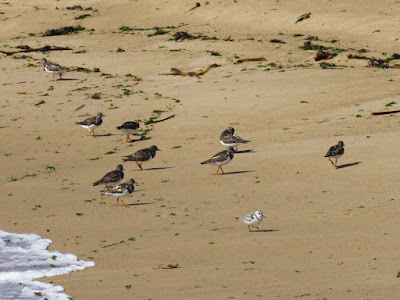Yesterday afternoon, I returned to Valdoviño. I recognize that expected a bit more birds, because migration pass is crossing its high point. But there were not many "bird news" around. Most outstanding watching was this Yellow Wagtail (Motacilla flava), german type. Several subspecies have been clasified for this nice Wagtail in Europe. By color in face and throat feaders I think this individual belongs to central Europe type (Damián, am I right?).
- 14 Common Ringed Plovers (Charadrius hiaticula).
- And a group of 20-25 Sanderlings (Calidiris alba)
Yellow Wagtail (Motacilla flava flava)
In "Botes beach", same waders remain there from days ago:
- 15 Ruddy Turnstones (Arenaria interpres)
Ruddy Turnstones (Arenaria interpres)
- 14 Common Ringed Plovers (Charadrius hiaticula).
Common Ringed Plovers (Charadrius hiaticula)
- And a group of 20-25 Sanderlings (Calidiris alba)
Sanderlings (Calidris alba)
We have an enormous problem with people´s pets in galician beaches. Owners often lose their dogs taking no notice of sinals and laws, wich require to get animals tied with lead. Yesterday, however, an exception appeared in "Botes". A very polite man, after saw me taking photos, asked if he could pass for there. I answer so, and he crossed beach with his tied dog without protest any word. Oh, Yeah!
After, I moved to Frouxeira lagoon, close to there. Water level keeps on high, and channel to sea is closed. As a resault, birds watching is not an easy job, and there are not many species, although were inmersed in migration top moment. Most important watchings were:
- 70+ Gadwalls (Anas strepera)
- 5 Tufted Ducks (Aythya fuligula)
- 1 Mandarin Duck (Aix galericulata). This specie doesn´t nest here. I don´t know if could be a wild specimen (...from Britain?) or a scaped one, from a domestic collection.
- 154 Eurasian Coots (Fulica atra)
Mandarin Duck (Aix galericulata)
And the last one. Before come back Ferrol, I went to Taraza fields. There, I watched some typical little birds in September month, as Whinchat (Saxicola rubetra, but only one specimen...), Willow Warblers (Phylloscopus trochilus), or Common Whitethroats (Sylvia communis), that now behave as a migration bird in zone, but was nesting in 80´s. I could take some photos of an European Pied Flycatcher (Ficedula hypoleuca), certainly common by here during autumn.
European Pied Flycatcher (Ficedula hypoleuca)
One more time, I apologize for grammatical mistakes I´m sure I make.
See you.









Hi Xabi!
ResponderEliminarWell, I'm not an expert in wagtails (nor in geese, nor in... anything!), but that bird looks OK for M. f. flava. I guess this taxon should be regular by this time of the year in Galicia.
Great pictures and perfect English, by the way.
Cheers,
Damián (soon back in GZ)
" Nor in geese", ha, ha.. No comments.
ResponderEliminarThanks a lot, my dearest "bioman" (biological-man, I refer).
PD: It´s not cause "my" english, but my fantastic "Oxford study" Dictionary.
Hi Xabi!
ResponderEliminarGreat pictures and post.
The Yellow Wagtail... buffff. I´m sure you know I´m not an expert in wagtails and pipits :), and after said by Damian only I can be quiet. But in my humble opinion, this is good for M.flava iberiae, that white throat contrasting with brigth yellow breast is not present in M.flava flava.
Cheers,
Marcos
Mmmmm... Marcos, this "contrast" between "white throat" and "yellow breast" seems to be so, perhaps, when you see these two photos. But I can assure you that throat was yellow (cleared and weared out, but yellow). But that images I took wasn´t correctly focused, and I din´t published them.
ResponderEliminarThanx for visit!